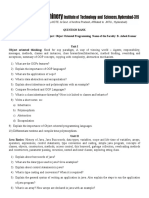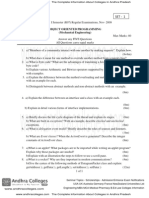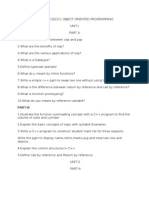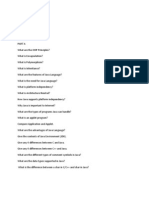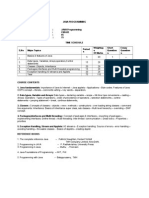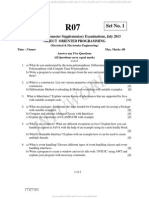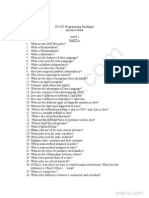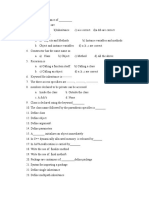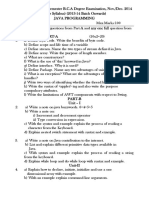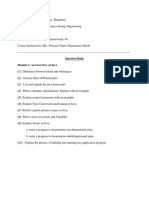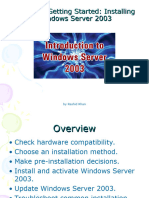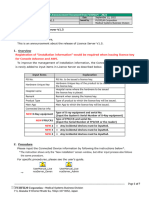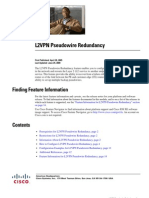Faculty of Engineering & Technology
Department of Computer Science & Engineering
Question Bank
Subject:OOPS with Java Semester: III
Subject Code: 22CS35 Academic Year:2023-24
Module I: Introduction to Object Oriented Concepts: Procedure–Oriented and Object Oriented
Programming System, Principles of Object Oriented Programming, Differences between C , C++ and
Java, Console I/O, variables and reference variables, Function Prototyping, Function Overloading.
Class and Objects: Introduction, member functions and data, objects and functions.
Q. Questions CO PO RBT Marks
No.
1. Distinguish between Procedure Oriented and
Object Oriented Programming.
2. What is OOP? Explain three principles of Object
oriented programming.
3. Compare C, C++ and JAVA.
4. Explain console input and output.
5. Implement a C++ program to find area of rectangle
(area=base*height),Area of circle (area=pi*r*r)and
area of triangle(area=1/2*base*height) using
function overloading concepts. Call these functions
from main with suitable inputs.
6. Define variable? Explain reference variables in C+
+ with programming example.
7. What is function prototyping? Explain with syntax
and example.
8. Define function overloading? Explain with an
example.
Page 1 of 8
� 9. Develop a program to show the working of scope
resolution operator.
10. Write a note on scope resolution operator and this
pointer.
11. Discuss the declaration and usage of static data
member?
12. What is an inline function? What are the
advantages of inline function? Give a suitable
example.
13. Why friend functions are required? Write a C++
program to illustrate the use of friend function.
M Module II: Introduction to Java: Bytecode, Features of Java, Java Applications, Building and
Running Java Program, Java Tokens, Data Types, Variables, Operators, Type Conversion and Casting,
Arrays, Access Specifiers, Control Statements.
C classes: Classes fundamentals, Declaring objects, Constructors, this keyword, garbage collection.
1. List and explain the features of JAVA
2 Explain the process of compiling and running the
JAVA program with the help of hello world
program.
3 Explain scope and life time of variables with
example.
4 Discuss primitive data types used in JAVA.
5 Explain bit-wise logical operators consider a=3 and
b=6 apply bit wise logical operator on their
operands and print suitable results.
6 Explain Boolean logical operators with example.
7 With an example explain ternary operators? Write a
program to find biggest among 3 members using
Page 2 of 8
� ternary operator.
8 What is type conversion and type casting in java?
Write a java program to illustrate type casting of the
data type and type conversion.
9 What are access specifiers? Explain them.
10 Explain the concept of array in java with an
example.
11 With syntax and example explain if,if-else and
nested if statements.
12 With suitable example explain the jump statements.
13 Explain with an example while and do-while loop.
14 How for each is different from for loop? Develop a
program to show the working of for each loop.
15 What is class? How to declare the object for the class
explain with an example.
16 Define constructor? What are the rules to write
constructors? Give an example.
17 Discuss the following
1) Default constructor
2) parameterized constructor
18 Explain the following
1) use of this keyword
2) Garbage collection.
M Module III: Inheritance & Exception Handling: Inheritance: inheritance basics, using super, creating
multi level hierarchy, method overriding. Exception Handling: Exception handling in Java.
PaPackages & Interfaces: Defining Package, Access Protection, and Importing Packages; Interfaces:
Defining and Implementing Interfaces, Nested Interfaces.
Page 3 of 8
�Q. Questions CO PO RBT Marks
No.
1. Define inheritance? Explain with suitable example.
2. Develop a program to show the use of super
keyword.
3. Explain method overriding with an example?
4. Write a program in Java that implements multi-
level inheritance.
5. Distinguish between method overloading and
method overriding in java with suitable example.
6. What is an exception? Explain the following
a) try
b) catch
c) throw
d) throws
e) finally
7. What is an interface? Explain how to define and
implement by taking suitable example.
8. What is package? How to create and import
package in java. Explain with an example.
9. Describe the levels of access protection available
for packages.
10. Differentiate between class and interface.
11. Explain nested interface with an example.
12. Explain the following with example
a) Creating a multilevel-hierarchy.
b) Variables in interface.
Page 4 of 8
�Module IV: Multi Threaded Programming, Event Handling
Multi Threaded Programming: What are threads? How to make the classes threadable; Extending threads;
Implementing runnable; Synchronization; Changing state of the thread; Bounded buffer problems, readwrite
problems, producer-consumer problems.
Event Handling: Two event handling mechanisms; The delegation event model; Event classes; Sources of
events; Event listener interfaces; Using the delegation event model
Q. Questions CO PO RBT Marks
No.
1. What is thread? Explain two ways of creating a
Thread in java.
2. Describe the need of thread synchronization. How
it is achieved in java programming? Explain with
suitable program.
3. Write a java program for Producer and Consumer
problems in thrads.
4. Write a java program that creates threads by
extending tread class.
a. First thread display “Good Morning” every 1
sec.
b. Second thread displays “Hello “every 2 seconds.
c. Third display “Welcome” every 3 seconds.
5. Explain with an example inter-thread
communication.
6. How to change state of thread. Explain with an
example?
Page 5 of 8
� 7. What is event handling? List out the available
event classes and explain it.
8. Briefly explain delegation event model.
9. List and explain event-listener interfaces.
10. Discuss about following using delegation event
model.
a) Handling mouse events.
b) b Handling keyboard events.
11. Explain the following
a) ActionEvent Class
b) AdjustmentEvent Class
c) ContainerEvent Class
d) InputEvent Class
e) MouseEvent Class
M Module V: Applets: Applet basics, Applet Skeleton, Simple Applet Display Methods, Repaint method,
Simple Banner Applet, HTML Applet Tag, Passing Parameters to Applet, getDocumentBase and
getCodeBase methods,AppletContext Interface.
Java Input/Output: Stream classes, Byte Streams: InputStream, OutputStream, FileInputStream,
FileOutputStream, PrintStream, DataInputStream, DataOutputStream;
Q. Questions CO PO RBT Marks
No.
1. What is an applet? Explain two types of applets.
2. Describe any 5 methods defined by Applet.
3. Explain Paint() and Repaint() methods of an
applet.
4. Explain the skeleton of an Applet.
Page 6 of 8
� 5. Write a simple Applet program to print the
message “This is my simple Applet” with suitable
steps to execute an Applet.
6. Discuss the HTML Applet Tag with its syntax.
7. How to pass parameters to Applet? Explain with
an example.
8. Explain the concept of getDocumentBase() and
getCodeBase() with examples.
9. How do applet different from application? Explain
with an example.
10. Define InputStream? Explain the methods defined
by InputStream.
11. Define OutputStream? Explain the methods
defined by OutputStream.
12. Explain FileInputStream with an example.
13. Explain FileOutputStream with an example.
14. Briefly explain PrintStream.
REVISEDBloom’sTaxonomyActionVerbs
Definitio I. II. III. Applying IV. Analyzing V. Evaluating VI.
ns Rememberin Understanding Creating
g
Bloom’s Exhibit Demonstrate Solve Examine and Present and Compile
Definitio memory of understanding of problems to break defend information
n previously facts and ideas new situations information into opinions by together in a
learned by organizing, by applying parts by making different way
material by comparing, acquired identifying judgments by
Page 7 of 8
� recalling facts, translating, knowledge, motives or about combining
terms, basic interpreting, facts, causes. Make information, elements in a
concepts, and giving techniques and inferences and validity of new pattern
answers. descriptions, rules in a find evidence to ideas, or or proposing
and stating main different way. support quality of work alternative
ideas. generalizations. based on a set solutions.
of criteria.
Verbs • Choose • Classify • Apply • Analyze • Agree • Adapt
• Define • Compare • Build • Assume • Appraise • Build
• Find • Contrast • Choose • Categorize • Assess • Change
• How • Demonstrate • Construct • Classify • Award • Choose
• Label • Explain • Develop • Compare • Choose • Combin
• List • Extend • Experimen • Conclusion • Compare e
• Match • Illustrate t with • Contrast • Conclude • Compile
• Name • Infer • Identify • Discover • Criteria • Compos
• Omit • Interpret • Interview • Dissect • Criticize e
• Recall • Outline • Make use • Distinguish • Decide • Construc
• Relate • Relate of • Divide • Deduct t
• Select • Rephrase • Model • Examine • Defend • Create
• Show • Show • Organize • Function • Determine • Delete
• Spell • Summarize • Plan • Inference • Disprove • Design
• Tell • Translate • Select • Inspect • Estimate • Develop
• What • Solve • List • Evaluate • Discuss
• When • Utilize • Motive • Explain • Elaborat
• Where • Relationshi • Importanc e
ps e • Estimate
• Which
• Simplify • Influence • Formula
• Who
• Survey • Interpret te
• Why
• Happen
• Take part in • Judge
• Imagine
• Test for • Justify
• Improve
• Theme • Mark
• Invent
• Measure
• Make up
• Opinion
• Maximiz
• Perceive
e
• Prioritize
• Minimiz
• Prove
e
• Rate
• Modify
• Recomme
• Original
nd
• Originat
• Rule on
e
• Select
• Plan
• Support
• Predict
• Value • Propose
• Solution
• Solve
• Suppose
• Test
• Theory
Page 8 of 8




